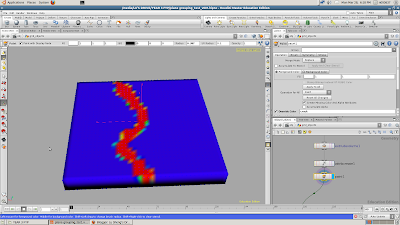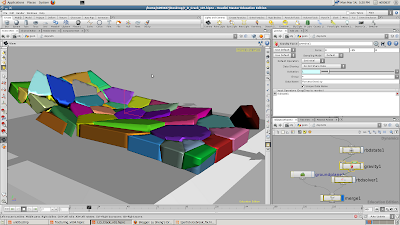Day 18
I continue doing research for the cracking of the earth. I post a thread on odforce but ended up with no reply. And there isn't really much help online too regarding my problem.
I consulted Mr Ron and he gave me his idea/solution. Below is how it looks:
Mr Ron first made a grid and use a mountain and smooth to make it look like a terrain. Then he used a cookie and separated both sides of the terrain into different geometries. He extruded the plane and added subdivisions to the extruded height of the plane. He then group the intersecting edges and used a point node with a ramp to control the jaggedness of the edges. Then a facet is used before it is connected to a voronoi fracture node. Then he used a point node to animate the terrain opening up by using this expression for the position attribute:
$TZ + ($BBX *smooth($F,1,200))+.5
What this does is it adds the bounding box value of X to the position value in Z. The smooth function is to allow it to move from 0 to 1 within frame 1 to 200. The addition of 5 is to close up the geometry with the other side.
The other side is repeated and a merge tool is used to join them together.
This is how it looks when the terrain opens up:
Now Mr Ron started to set up the hierarchy for the pieces collapsing. It typically is exactly the same as what is shown last week to Mr Douglas.
A box is set up and a point node with a expression
$TZ *$BBX is used to make the box look like how the crack on the earth will spilt apart.
A transform node was used to animate the box:
A timeshift node is used to time when the box will start scaling up. But in this case is after frame 50 as he didn't want the pieces to start collapsing almost immediately when the crack just opened up. Next a group node is used to group the points within the bounding box of the box. Then the points that are affected are coloured red. A foreach node is used to promote the points parameters into parameters for the primitives, in this case the pieces which are going to fall. Then the sequence is saved out and re-imported, to reduce the time needed for cooking.
Inside the dop network, the same hierarchy is used before. A rbdglueobject is used to import the geometry. Then a group node to group the pieces which are going to fall according to colour. Then a gravity node is used to make them fall. A rbdstate node is used to only activate the pieces which are going to fall and nothing else. And a solver is also used.







































